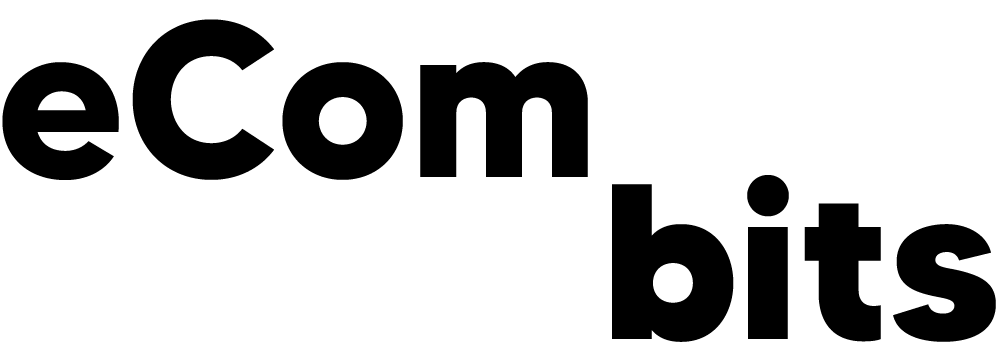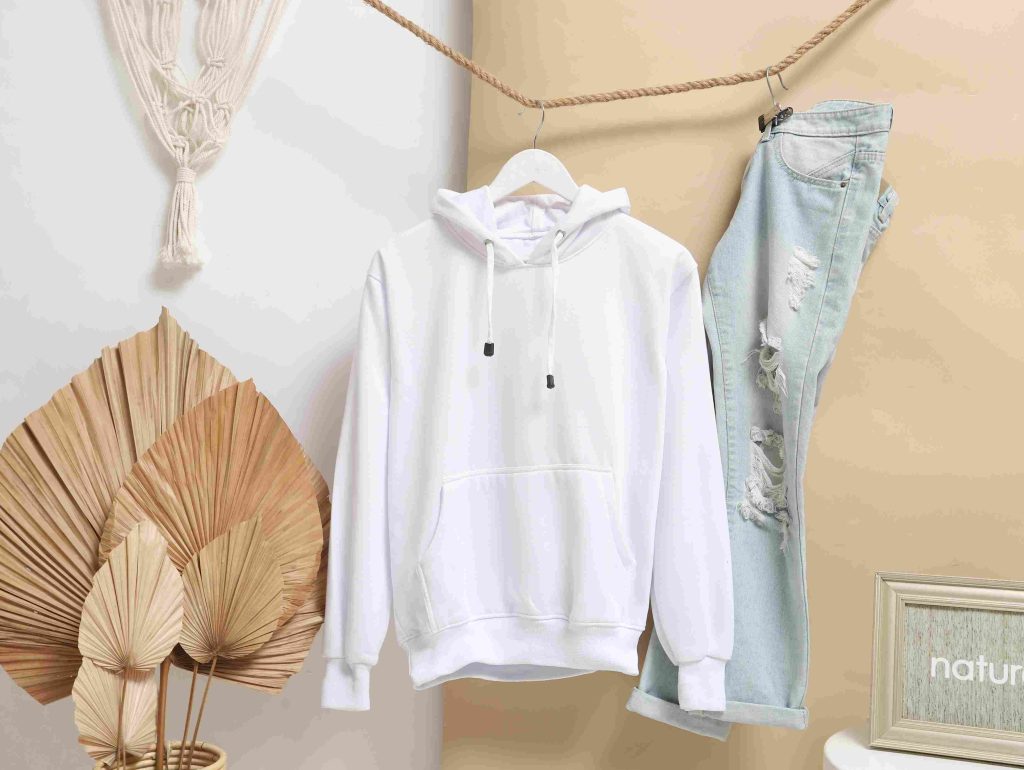This is an in-depth guide to starting a print on demand business in 2023.
If you’re new to print on demand business, read on and you’ll learn:
- How print on demand works
- What the pros and cons of print on demand are
- How to create a successful print on demand business from scratch, from researching ideas to creating products and marketing your store
Let’s get started.
Print on demand: an Introduction
What is print on demand?
Print on demand (also known as POD) is a business model, in which you work with a printing partner to create products with your custom designs (shirts, hoodies, mugs, etc.) and sell them under your own brand on a per-order basis.
Once you receive an order, everything from printing to shipping to the end customer is handled by your printing partner, like Printful or Printify.
Because products are printed on demand, you don’t need to buy blank merch in bulk and hold an inventory.
How does print on demand drop shipping work?
Here’s how print on demand drop shipping works:
- Create unique designs
- Team up with a print on demand company and connect it to your website
- Sell products with your designs in your own online store
- Print on demand company prints, packs and ships the product directly to your customer
POD companies take care of a major part of order fulfilment. Thanks to this solution, you don’t have to worry about managing a stock of goods, buying equipment, hiring staff and more.
Here’s a list of things POD companies handle for you:
- Stock. POD companies have stocks full of blank products. As a business owner, you don’t have to worry about ordering blank products in bulk and storing them.
- Printing equipment. Large printing facilities operate expensive printing machines. You get to create high quality prints without investing anything in printing equipment.
- Staff. There’s no need to learn how to operate the printers yourself or hire skilled staff.
- Production. Once you receive an order in your online store, your printing partner takes full control of production process.
- Packing and shipping. Printed goods are packed and shipped directly from the printing facility to your customer.
Your main responsibilities as a POD store owner are:
- Design. From choosing the right product to creating high-quality print-ready files.
- Online store management. You take care of domains, hosting, managing products and orders with an eCommerce platform of your choice. For example, Shopify or WordPress.
- Marketing. Including ad strategy, running social media channels and analysing results.
- Customer service. You handle all communication with your customers: questions, complaints, returns, exchanges and more.
Print on demand pros and cons
| 👍 Printing, packing, shipping handled for you | Instead of worrying about handling blank product stock, buying equipment and printing products, you can focus on designing the right products and running successful marketing campaigns. |
| 👍 Hundreds of customisable products | Come up with design ideas and create as many unique products as you like. From apparel, accessories and shoes to home decor and stationery. |
| 👍 Run experiments without risk | You can tweak your designs dozens of times until they really speak to your target audience. And you won’t end up with a warehouse full of unwanted goods. Your only investments in the testing process – personal time and marketing expenses. |
| 👍 Work with multiple POD partners | You’re not tied to a single printing facility. In fact, you can collaborate with as many printing partners as you like. If one prints bean bags and the other offers home decor, why not work with both. |
| 👍 Be located anywhere in the world | It doesn’t matter where in the world you are located. Your target audience doesn’t have to be in the same country as yourself. Just choose a POD company that has printing facilities close to your target audience’s location. |
| 👎 Order fulfilment time | When you have a stock full of printed merch, all you have to do is ship it to your customer. In case you run a print on demand business, count in at least a couple days extra for production. Most customers don’t realise how POD works. That’s why users often expect immediate shipping. It is your job to clearly communicate the production time in your product listing. |
| 👎 Production delays | Usually you should allow around 2-3 working days to get your order printed and shipped out. However, it’s not always the case, especially during peak sales season. If your store gets busy before Christmas, you can only imagine how busy your POD company’s printing facilities are. There are thousands and thousands of orders from other POD business owners, who are taking advantage of the peak season just like yourself. So be prepared to wait. And be ready to communicate about delays with your customers. |
| 👎 Variance and mistakes | All products are printed on demand one at a time. There is no production line that would guarantee that every product is exactly the same. Since all POD products are essentially handmade, expect that printing outcomes can vary slightly. Usually it’s not very noticeable. Another thing. Just like in any production process, there will occasionally be mistakes. Wrong prints, bad prints, mistaken print areas. These things are a part of POD business, so be ready to deal with them and communicate with your POD company about them. |
| 👎 Product availability | It’s not common that your POD company runs out of a particular product or discontinues it entirely. However, my experience shows it can happen. Especially if your customer orders a shirt in an uncommon color in the peak sales season. For example, “Solid Banana Cream” color tee. How many Solid Banana Cream tees do you think they have in their inventory? To avoid delays, I recommend sticking to popular colors, like white, black, heather grey. |
How to Start a Successful Print on Demand Business in 2023
Now, let’s go through all the steps of creating a successful POD business, from niche research to marketing your store.
Here are the 10 steps to start a print on demand business:
- Research
- Pick a print on demand company
- Choose products and fulfilment methods
- Create designs
- Order samples and get feedback
- Create mockups
- Build an online store
- Import products to your website
- Refine and test
- Promote your store
- Bonus tip: Be patient and persistent
1. Research
Here’s the first question you should ask yourself if you want to start a print on demand business.
What’s your target audience? In other words, What’s your niche?
There’s no need to think about designs, product choices, print on demand companies, before you’ve figured out your target audience.
Consider your passions
To begin your research, consider all the things you truly love. What are you passionate about? What do you believe in? What causes would you fight for?
Your passions don’t necessarily need to have great social or political causes behind them. Is your favorite food pineapple pizza? Are you a proud French bulldog owner? That’s a great start.
I strongly believe in creating business ideas, based on personal interests. Building a business takes countless hours of hard work, so it will be easier to deal with challenges if you are emotionally invested in the topic your business is about.
Explore niches and sub-niches
Now, let’s take a more structured approach to niche research.
A niche is a focused, targetable segment of a larger market that attracts a specific audience.
If your brand is niche-oriented, it caters to the unique demands of the niche audience, which aren’t addressed by mainstream businesses.
For example, you will find tons of cat-themed T-shirts in mainstream shops. However, there are a lot less French bulldog products. This is where a niche brand can step in and sell unique Frenchie products to the passionate audience of Frenchie lovers.
Niche research
Jobs, hobbies, sports, family status and pets are broad categories with tons of passionate and pride-filled niches.
There are thousands of niche options, so pick the ones that you personally know. Don’t choose nurses or knitters just these niches are profitable. Choose them if you understand their needs and are ready to come up with unique solutions for them.
Any niche can be profitable if your product fits the needs of the niche audience.
Wikipedia lists are an excellent starting point for your niche research.
- List of occupations
- List of hobbies
- List of sports
- List of cat breeds
- List of dog breeds
The better you’ve defined your niche, the easier it is to create products for your target audience’s needs and interests. However, don’t go too specific because you’ll risk having a limited market and may struggle to grow your business in the future. It’s important to strike a balance between being specific enough to cater to your audience’s needs and broad enough to reach a wider range of potential customers.
Understand your target audience
Let’s suppose you’ve decided to focus on French bulldogs.
Facebook Business Manager Audience Insights show that there are 3.5-4M people around the world with this interest, 69% of them are women.
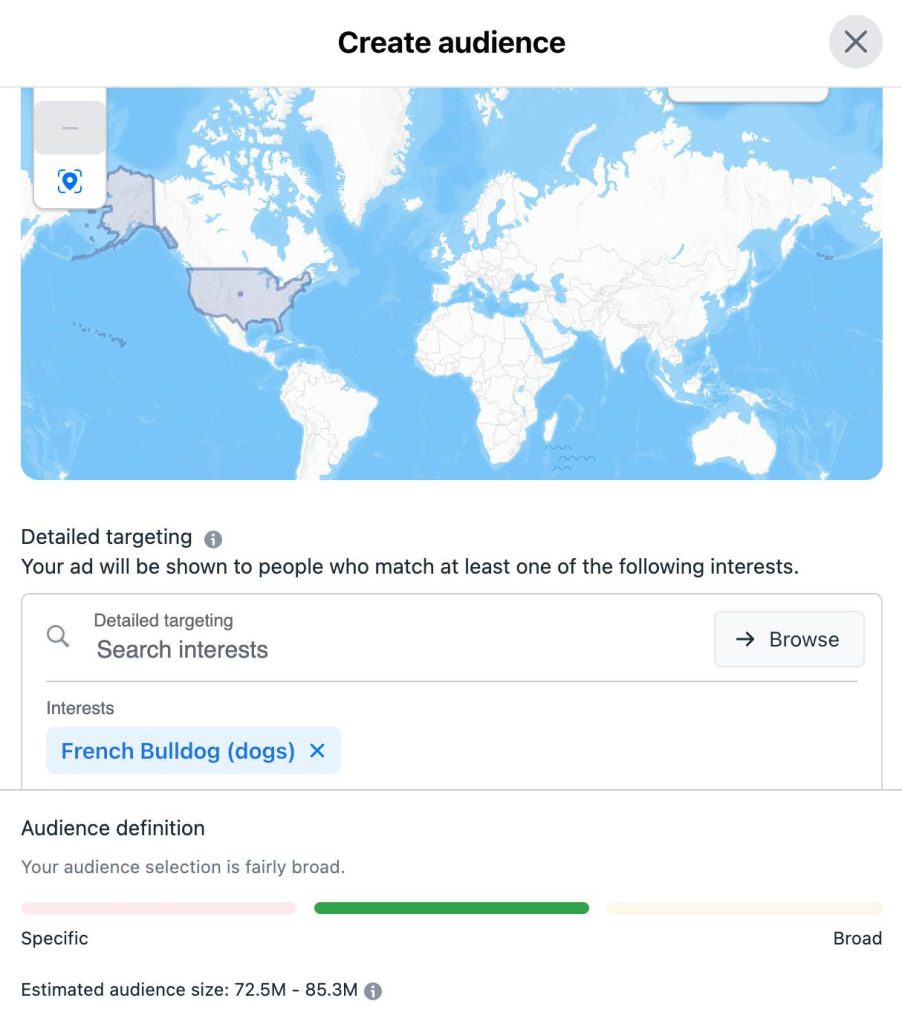
Check target audience location
Knowing where your target audience is located is crucial for several reasons:
- Audience location affects your choice of print on demand company
If you are selling products to US customers, you want to print them in the US, too. If goods are produced close to your customer, delivery times are shorter. As a result, this may improve customer satisfaction.
- Audience location affects marketing decisions
Depending on the countries you want to target, your ad visuals and social media channels may have to be adjusted.
- Audience location affects your online store setup
Consider everything from your online store language to currency and tax policy.
Evaluate competition
Competitor analysis is a must.
In 2023, if there are no competitors within a niche, there is probably no demand. Shopify sites and POD marketplaces offer thousands, if not millions, of print on demand products for every group of people you can potentially imagine.
Having strong competitors is great. Your task is to come up with even stronger designs and better marketing solutions.
I like to check competition within a niche, using online marketplace like Etsy, Amazon, RedBubble, Society6, Spreadshirt, etc.
Here are some awesome French bulldog product examples I found on Etsy.
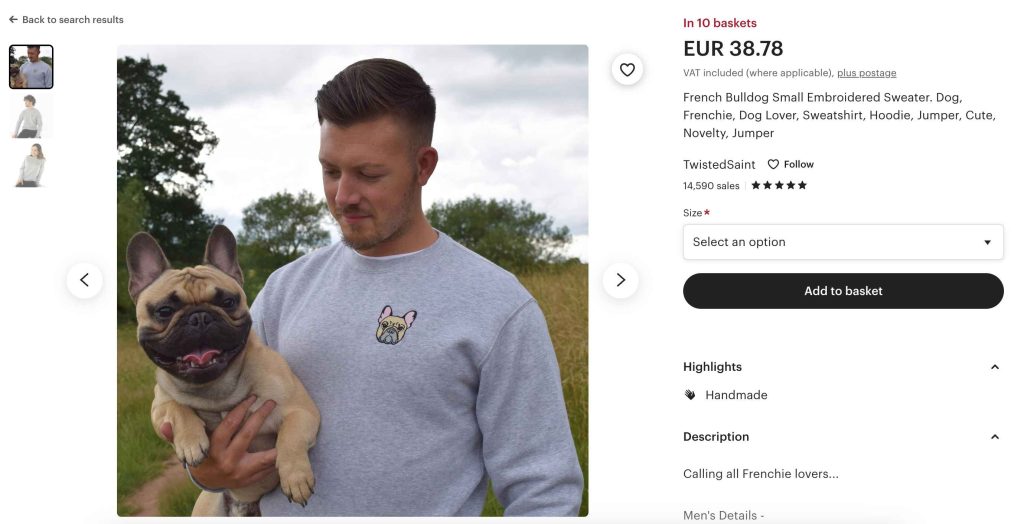
This store sells custom embroidered pet sweatshirts that buyers around the world love because they can personalize it with their pet’s embroidered picture. By focusing on a specific niche of pet owners who love to pamper their pets, the store has been able to create a loyal following of customers who appreciate the unique and personalized products they offer.
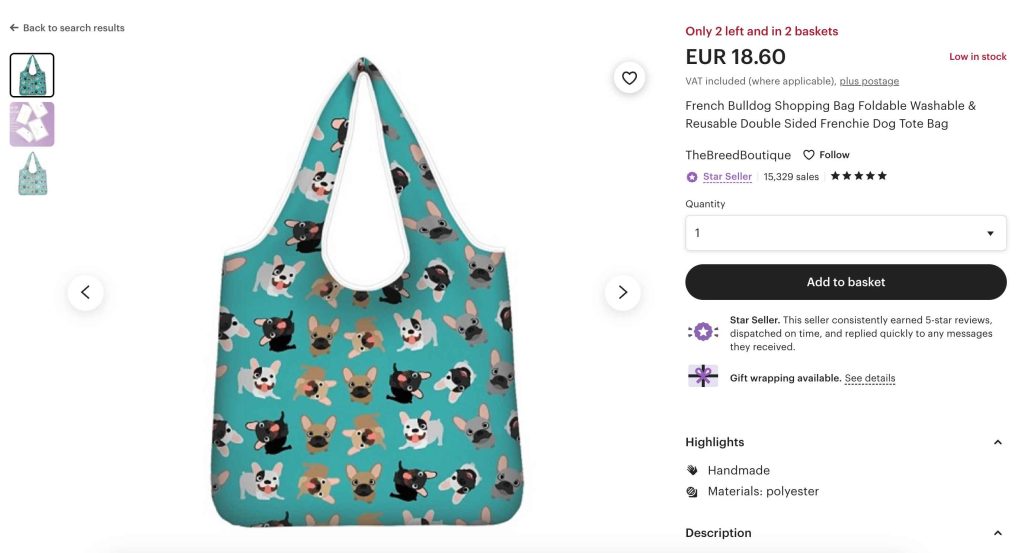
Another store offers all over print POD tote bags with frenchies. This store doesn’t offer personalization and therefore saves time on customization and maintains competitive prices.
Double-check that your niche is targetable
Social media ads are the primary source of traffic for my POD stores, therefore, I rely heavily on Facebook’s targeting capabilities.
If you’re planning to use Facebook or Instagram ads to promote your business, this step is crucial.
Go to Audience Insights in Facebook Business Manager and type your niche name under Interests.
If your niche pops up and you can select it (like above), you’re good to go.
However, this is not always the case.
I had to learn this the hard way. A while ago I got an axolotl as a pet and started designing axolotl merch. Unfortunately, only then I realised that I cannot target axolotl lovers on Facebook, because the niche is too small.
2. Pick a Print on Demand Company
Why do you have to pick a printing company before you have designs and an online store?
Because the whole concept of your store, the products you sell and the design guidelines all depend on the print on demand company you choose.
In this chapter, I will quickly outline the most popular print on demand companies, point out their pros and cons and specify what kind of businesses they are perfect for.
Let’s dive in.
Printify
Printify is a print on demand fulfilment service that connects you to the biggest printing facilities around the world. Currently it works with printing facilities in the US, Canada, the UK, Germany, Czech Republic, China and Australia.
Using Printify app, you can design unique products and import them into your online store. Once a customer makes an order in your store, Printify will handle printing and shipping directly to your customer.
TIP: Printify is very competitive in terms of pricing, so many of its products are priced considerably lower than its competitors’. Printify is the perfect POD company to choose if your primary concern is the profit margin.
Choose Printify if:
- You want to maximise profit
- You want to choose from a vast variety of products
Click here to try Printify free
Printful
Printful is the biggest print on demand drop shipping company that helps you sell custom merch (shirts, hoodies, mugs, etc.) in your own online store.
Printful stands out with consistent print quality, a variety of branding options (labels, custom packing slips, pack-in business cards) and fast fulfilment (2-3 business days in my experience).
However, Printful’s product costs are considerably higher than Printify’s. If you are looking for a POD company with the lowest product costs, you’ll have to take a look at other services.
Choose Printful if:
- Consistency of quality is of top importance to you
- You want to invest in branding and create a special experience for your customers
Click here to try Printful free
Other POD companies
Gooten
Gooten is not as well-known as Printful and Printify, but it’s worth being considered, thanks to the unique products and good prices it offers.
If you’re interested in unusual print on demand products, like camo shirts, acrylic trays, black mugs or cool baby products, make sure you check out Gooten Product Catalog.
Gooten is not my first choice, because the platform is quite laggy and not easy to use at all. In addition, you can’t choose the printing facilities where your products will be printed, which leaves you with a lot of uncertainty in terms of print quality.
TeeLaunch
TeeLaunch is a Shopify print on demand app, which is considerably smaller than Printful or Printify, but which might still be interesting for Shopify store owners. TeeLaunch prices are lower than Printful’s but not quite as competitive as Printify’s.
SPOD
SPOD is another Shopify print on demand app that currently prints goods only in the US, but plans to expand to Europe, too. The company promises 48h production time.
CustomCat
CustomCat is a print on demand company that prints goods at a single facility in Detroit, and uses DTG, embroidery and sublimation technologies. It integrates with Shopify, Etsy, BigCommerce, and WooCommerce, as well as offers an API integration for custom solutions.
RedBubble, TeePublic, Society6, Threadless, etc.
These are print on demand marketplaces that function a bit different, compared to all the print on demand companies above.
Print on demand marketplaces let artists and designers upload their designs and sell them on the marketplace.
The benefit of this approach is that your designs get tons of exposure from marketplace visitors, plus you don’t have to worry about building and managing a website, figuring out payment getaway solutions, etc.
There are so many differences between POD marketplaces and POD companies like Printful, Printify and Gooten that this topic deserves a separate blog post. In this post, let’s focus on POD fulfilment companies rather than marketplaces.
3. Choose Products and Fulfilment Methods
Browse through Product Catalogs
Printify, Printful and Gooten offer a variety of products, from apparel to accessories, homeware and pet products. The range of products is very different for each of these companies, so I recommend looking through all of the catalogs below to understand what’s on offer.
Product Catalogs
TIP: If you like products from different POD companies, you can sign up with several of them. For example, if you want to print T-shirts with Printful and shower curtains with Printify and sell them in one online store, that is totally possible.
Choose a printing method
Here are the 2 most popular print on demand printing methods:
- DTG (direct to garment)
- AOP (all-over-print)
DTG is a printing method, in which ink is sprayed onto a ready-made garment. DTG is the most popular printing method – it’s affordable and fits the needs of most POD business owners.
If you choose DTG, the printing area is always limited. It means that you can print a design on the front or the back of the shirt within a particular area. The print won’t cover the whole product from seam to seam.
DTG garments are mostly cotton-based.

AOP stands for all-over-print. In this printing method, your design covers the whole garment. It is first printed onto a fabric, then cut and sewn.
Printify has an awesome selection of products you can use for AOP technique, from T-shirts to dresses, bomber jackets and socks.
All-over-print garments are mostly polyester-based.
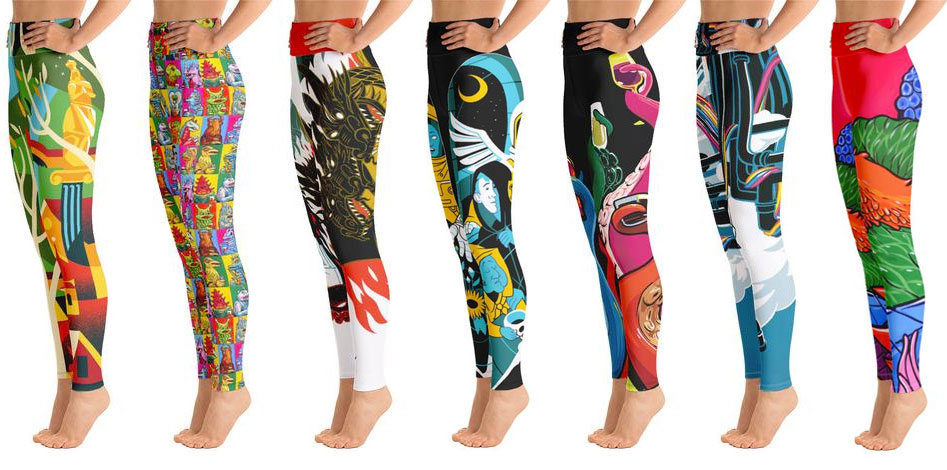
In addition to DTG and AOP, Printful and Printify also offer Embroidery. If you’re interested in embroidering your garments, these are the best POD companies for your business.
Find trending products
Google Trends is a free tool that provides data and graphs on the popularity of specific searches in Google.
If you’re not sure which products to pick, Google Trends can help you understand what people are actually searching for at the given moment.
In the screenshot below, you can see search interest for tote bags over the past 5 years.
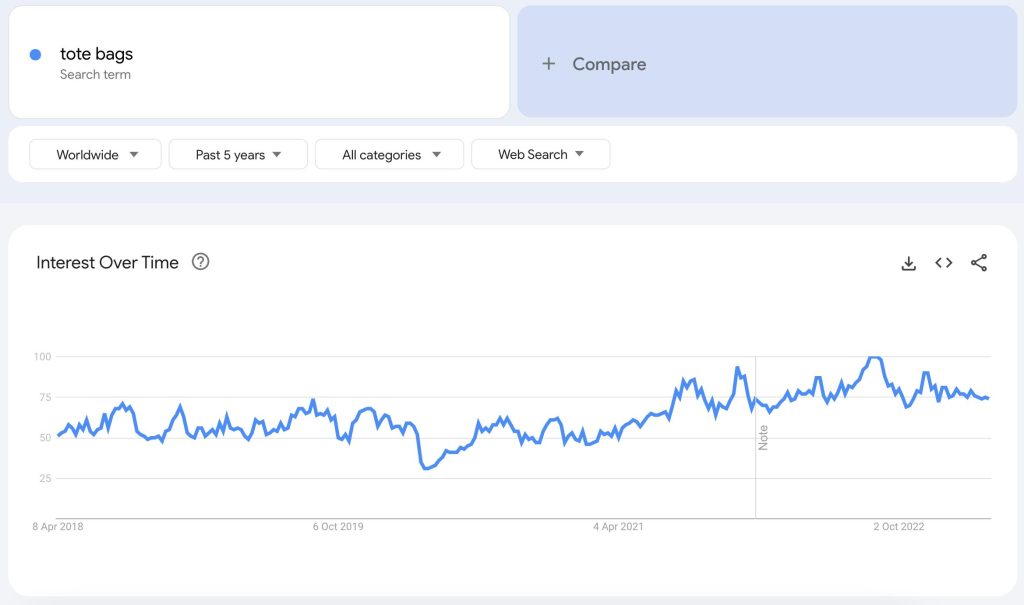
Take advantage of seasonal products
Both Printful and Printify offer a great variety of seasonal products, such as swimsuits, flip flops, beach towels, Christmas ornaments, Christmas tree skirts. Even hoodies are seasonal, since customer interest for them peaks in winter months.
No matter what your niche is, make sure you consider printing some seasonal products for extra revenue. Not all designs work well on specific products like bikinis, but it’s definitely worth looking into.
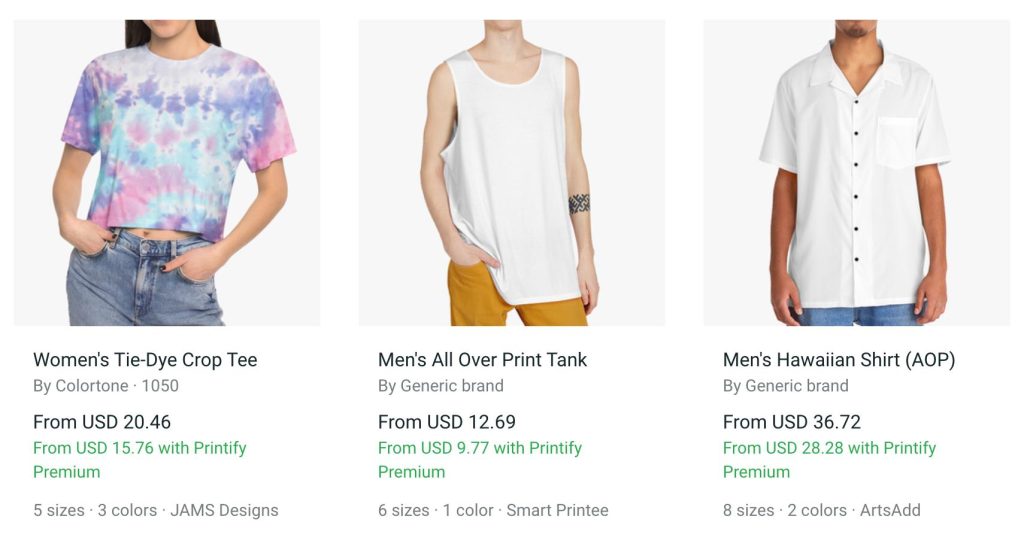
4. Create Designs
Research design ideas
Every print on demand entrepreneur has different ways of finding merch design ideas. Ways can vary, but one thing is clear – profitable ideas are rarely generated without substantial research.
You have to research your niche, see what works for other stores, understand what your strengths are, and develop unique designs based on that.
How can you research your niche in search of ideas?
- Pinterest. Pinterest is like a mood board with millions of interlinked ideas. Here you can look for general topics and subtopics that interest my target audience, visual style they are passionate about.
- Etsy. As a marketplace full of independent creators, Etsy is a great place to seek product inspiration. Visit Etsy to understand what kind of products and mockups work for your audience, what kind of artwork (in terms of color, placement, complexity) speaks to your audience the most.
- RedBubble, TeePublic, Society 6, Threadless and others. These are print on demand marketplaces where thousands of talented artists and designers upload their artwork. Just remember – seeking inspiration is okay but copying another person’s artwork is not.
- Google it. Sometimes this is the easiest and most effective research method. Pay especially close attention to niche products in Google Shopping!
- News. Sometimes news articles are the best sources of ideas, for example, if your store them connects with social or political causes or activism.
Niche down and combine niches to create unique design ideas
All niches can be divided further into sub-niches and sub-sub-niches.
Apart from niching down, you can also try combining niches to come up with very specific designs for very specific groups of people.
Here are some ideas:
- French bulldogs + careers (e.g., nurses with French bulldogs, veterans with French bulldogs)
- French bulldogs + family status (e.g., moms with French bulldogs, grandparents with French bulldogs)
- French bulldogs + hobbies (e.g., knitters with French bulldogs, Harry Potter fans with French bulldogs)
- French bulldog jokes
Nurses with French bulldogs could enjoy a shirt saying “Frenchie with a nursing degree”.
Harry Potter fans would totally get a shirt with Harry Potter characters reimagined as Frenchies.
5. Order Samples and Get Feedback
Don’t make the mistake of selling a product you haven’t seen in real life.
You can’t build a strong and sustainable brand if you don’t know the quality of your garments and prints.
Therefore, always order samples.
There are so many benefits to ordering samples before you start selling:
- You can evaluate the quality of the product
- You can make sure that colors are correct, the print file is not too detailed, pixelated or otherwise faulty
- You can make your own photos and use them alongside mockup images
- You can show the sample to your friends and ask for honest feedback
Once you have received the samples, show them to as many people as you can and ask for feedback.
Don’t be shy to ask for feedback online, for example, on Reddit threads or Facebook groups that your target audience uses. This is the moment when you can still tweak your designs as many times as necessary until you have the perfect product.
6. Create Mockups
A mockup is an image that visualizes how your product will look when it’s actually printed.
POD companies have mockup generators that automatically create mockups of all your products. You can then use these pictures in your online store to avoid the costs of hiring a professional model and photographer.
Use mockups provided by your POD company
Printful’s mockup generator is simply awesome. Not only is it very easy to use, it’s also free if you use their services! All you have to do is choose a product, upload your design and choose the photos which you want to put your designs on.
Printful offers basic product mockups on transparent or white background, mockups on male and female models, flatlays and more.
Take a look at the variety of Printful mockups for Bella+Canvas 3001 tee.

Printify’s mockup generator doesn’t offer such a variety of mockup options, but it still serves its purpose. And it’s free.

Use Placeit.net mockup generator
If you are looking for lifestyle images of your products, check out Placeit.net.
It’s a paid service ($7.47 per month) that lets you place your designs in various settings. Placeit mockup gallery is literally endless – there are 85000+ assets that you can sort by product type, model gender, age, ethnicity and much more.
Personally, I love Placeit for the simplicity it offers to POD business owners. Make sure you check it out if you’re looking for product photos that stand out from the crowd.
7. Build an Online Store
Choosing the right eCommerce platform is a big step that defines your whole print on demand journey.
Evaluate the features and costs of your eCommerce platform carefully to find a solution that is powerful yet easy to use, compatible with your POD company, as well as affordable.
Let’s take a look at some of the most popular eCommerce platforms:
- Shopify
- Wix
- Etsy
- WooCommerce
Shopify
Shopify is a reliable solution for beginners. Exceptionally simple and easy to use, it is the best option for those who have little experience in web design.
In addition to being beginner-friendly, Shopify also works effortlessly with most print on demand companies. Whether you’ve partnered up with Printful, Printify, Gooten, TeeLaunch or any other, you won’t have any problems connecting them to your Shopify store.

Print on demand companies with Shopify integrations:
- Printful
- Printify
- Gooten
- TeeLaunch
- SPOD
- CustomCat
Shopify pricing plans:
- Shopify Basic ($39 per month, plus 2.9% + 30¢ for each transaction)
- Shopify ($105 per month, plus 2.6% + 30¢ for each transaction)
- Shopify Advanced ($399 per month, plus 2.4% + 30¢ for each transaction)
Shopify Pros
- Biggest choice of POD companies
- Very easy to set up
- Requires no website development experience
- Great design options
- Excellent page load time
Shopify Cons
- Can be costly, especially if you invest in paid themes and extensions
- Limited customization, advanced features require a developer
Wix
Wix is an awesome solution for up and coming print on demand entrepreneurs.
It has an outstandingly simple drag-and-drop interface, it provides you with endless store design options, and it costs less than Shopify. The only downside is that not all print on demand companies have integrations with Wix.
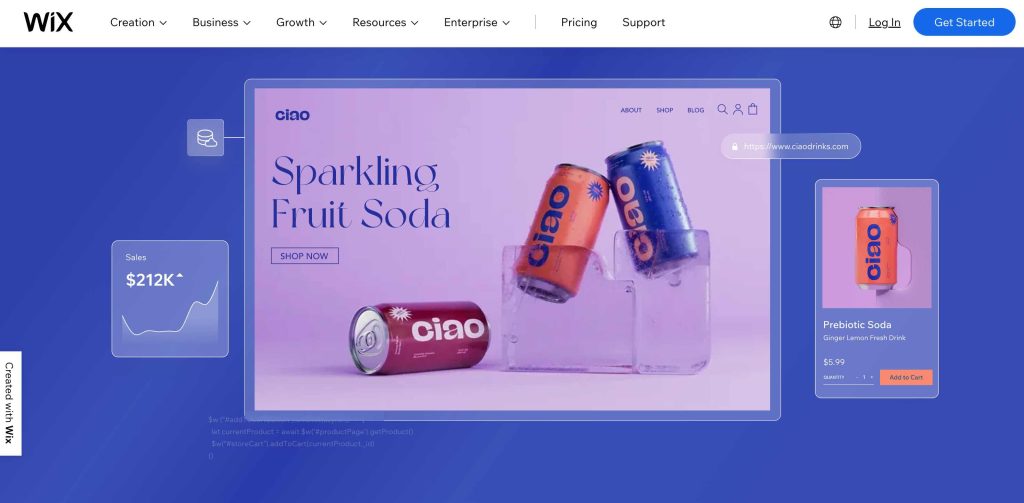
Print on demand companies with Wix integrations:
- Printful
- Printify
Wix Pricing plans:
- Connect domain ($5.50 per month, displays Wix branding)
- Combo ($10 per month, no hidden fees)
- Unlimited ($17 per month, no hidden fees)
- VIP ($29 per month, no hidden fees)
Wix Pros
- Affordable and really simple
- Tons of creative website themes
- Excellent blogging features
- Perfectly suited for small to medium-sized brands
Wix Cons
- Not all print on demand companies provide integrations with Wix
WooCommerce
WooCommerce is a WordPress plugin that turns your WordPress website into a functional online store.
The main benefit of WooCommerce is that it’s completely free, however, it comes at the price of spending tons of time on technical setup and literally zero support.
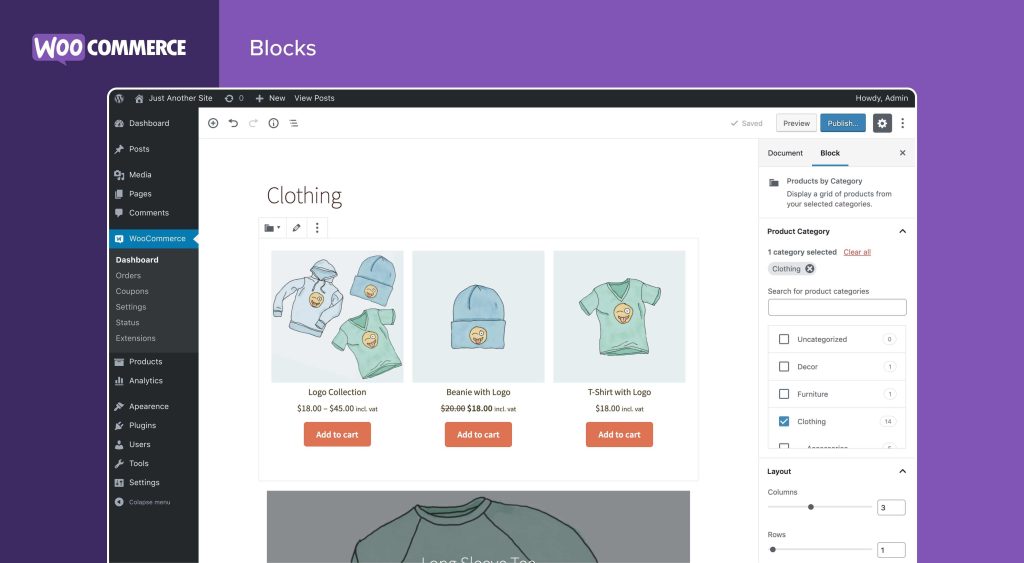
Print on demand companies with WooCommerce integrations:
- Printful
- Printify
- Gooten
- CustomCat
WooCommerce pricing:
- Free, no monthly fees
- Cost per transaction depends on the payment getaways you choose (Paypal, Stripe, etc.)
WooCommerce Pros
- Complete customization and control
- No monthly fees
- Lots of free plugins and templates from WordPress community
WooCommerce Cons
- Literally no support
- Requires at least a bit of technical knowledge
- Integrations with POD companies can be problematic and may require extra attention
- You have to manage everything from website hosting to design, maintenance and backups
Etsy
Etsy is an online marketplace of handmade goods, which also happens to be a popular eCommerce platform for print on demand sellers.
Compared to platforms like Shopify and Wix, which help you build your own website, Etsy actually places your listings among other sellers’ listings. This gives your brand more exposure, but also places you against tough competition.
The main disadvantage of Etsy is that it’s very difficult to keep your margins high because of Etsy’s transaction and processing fees.
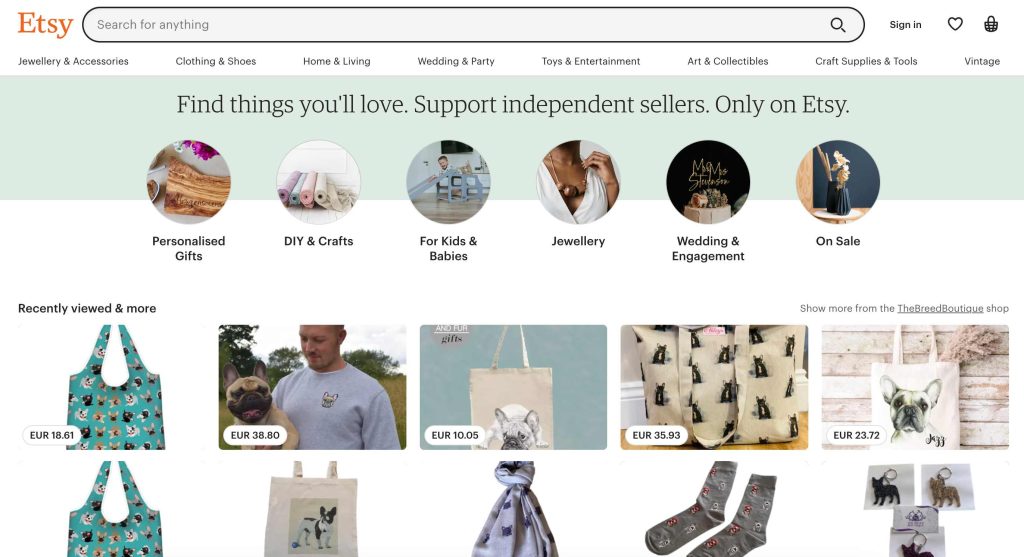
Print on demand companies with Etsy integrations:
- Printful
- Printify
- Gooten
Check out my full guide to print on demand companies that work with Etsy.
Etsy costs:
- No sign-up or monthly costs
- 20$ listing fee for each listing, listings must be renewed every 4 months
- 6.5% transaction fee for every listing sold
Etsy Pros
- Your listings get tons of exposure
- Creating a store is simple and requires very little technical knowledge
Etsy Cons
- Listing, transaction and processing fees make it hard to make a profit as a POD seller
- Your store doesn’t have a standalone website
8. Import Products to Your Website
Connect your store
It’s time to import the products you’ve designed into your online store.
First, you’ll have to connect your online store to your POD company.
Depending on the POD company and the e-commerce platform you’ve chosen, the steps will differ.
Visit your POD company’s Help Center to figure out the step-by-step process.
Update product descriptions and images
Once your products are all in your store, it’s time to get creative and transform your listings from generic to special.
Invest some time in uploading a variety of mockups or even your own photos. Come up with product descriptions that not only describe the fabric and the fit, but also explain the vision of the brand and the idea behind the design.
9. Refine and Test
Design a Logo
A brand without a logo is unimaginable. Beginning your print on demand journey with a professional logo will help attract the right customers and communicate your brand values better.
Refine Your Store’s Design
If you want to elevate your print on demand brand, you’ll have to find colors, fonts, illustrations and photos that are specific to your brand and its values.
Set Up Policies
It’s tempting to use copy-pasted Terms of Service and other policies, as provided by Shopify or taken from another website.
I wouldn’t recommend doing it, though.
Policies are essential, because they define how you behave in case of complaints. Here’s a list of recommended policies for every print on demand business:
- Terms of Service
- Privacy Policy
- Return & Refund Policy
- Shipping & Taxes
- Sizing Guide
Pay close attention to what other POD store owners write in their policies, take notes and create your own. Be concise, to the point, and always make sure that your customers can easily access and understand your policies.
Test Before Launching
Testing is a vital phase of any website development, which you should never skip.
What if the checkout process doesn’t work? What if link destinations are wrong? What if orders don’t get synced to your POD company’s dashboard?
To be sure that everything functions correctly, you should perform a variety of tests.
10. Promote Your Store
Become an Ambassador for Your Own Brand
No one knows more about your brand, its vision and mission, than yourself. Don’t be afraid to talk about it in public, show your ideas to friends, family and strangers, get some feedback.
Your brand can only be noticed if you make it visible, so go out there and make people interested in your brand’s vision.
Social Media
Nowadays it goes without saying that a brand, no matter the niche, should be active on social media. It’s not just the place where you connect with your audience, it’s also a place to sell your products.
Be an Active Member of Relevant Communities
You need to be as close to the people in your niche as possible. Find places where they actively interact, share their thoughts, tips and passions. Read everything they care about, become a part of the community.
In fact, it’s no longer about “them”. YOU need to become an engaged member of the community to be truly successful at running a POD brand. From now on, it should be about “us”, not “them”.
Find relevant Facebook groups and Reddit threads and join them right now. Even if your designs are not ready and the store is not launched. You can start discovering the topics and visuals your niche cares about already now, and use this knowledge to create more engaging designs.
Once designs are ready, share them with the community and ask for honest feedback. Don’t be afraid of feedback and be ready to make tons of design iterations until the design is not only perfect for the audience and visually appealing, but also well-suited for printing on the chosen product.
Start a Blog
Writing high-quality content relevant to your niche is time consuming and requires a lot of dedication. It is also the perfect long-term strategy to build authority within your niche, become a thought leader and inspire your audience.
As a result, you can not only achieve higher Google ranking, but also get valuable shares and backlinks from other blogs, businesses and news sites.
Use the power of Instagram influencers
Influencer marketing helps you get your products in front of new audiences, while using the audience trust and market expertise that the influencer has built. Audiences that influencers can get your product in front of are considerably larger than those you can reach organically.
Although not free, influencer marketing is a powerful tool for sales that are based on reviews and audience trust. As long as you pick the right influencers that connect with your audience and have a highly engaged following, the return on investment from influencer marketing can be even higher than from social media ads.
Invest in Paid Advertising
To be able to reach your ideal audience and boost website traffic without having to wait for months, run paid social media ads. I recommend starting with Facebook and Instagram advertising.
Social media ads let you show highly targeted tailor-made content to the people most likely to click through and make a purchase. It’s the perfect tool for online sales if your targeting, visuals and copy are right for the niche.
Note that there is no right or wrong way of doing ads for a print on demand business. What works for one niche might not work for another. That’s why the key to mastering social media ads is testing.
Bonus: Be Patient and Persistent
In print on demand business, there are no shortcuts to the success.
So many POD gurus keep talking about tricks and hacks to earn hundreds of thousands in 10 days. However, the only trick that works is patience.
It will take countless hours to get things right and you might lose a lot of money on the way. Stick to your dream and eventually it will be worth it.
Value every bit of feedback you get and use it to improve your business.
When you think you’re working hard enough, know that you can work even harder and do even better.
With this kind of mindset, every sale, even if it’s just $5 of profit, will be a little milestone to celebrate. As you celebrate little accomplishments and show pride in your business, more people will notice your brand and help you grow.
What’s Next?
I hope I’ve answered your question of how to start a print on demand business with this guide. I also hope that you’ve found some useful tips for your print on demand journey.
To find out more information about print on demand companies, check out my reviews:
